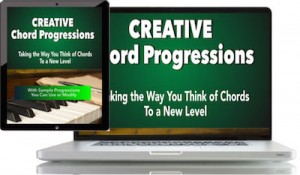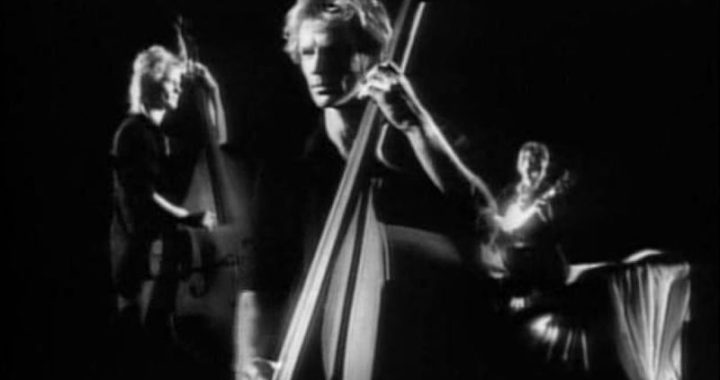Most pop songs, and all the related genres such as folk, country, etc., use simple, strong chord progressions. In fact, when you go back and look at complex prog rock tunes from the early to mid-seventies, you might be surprised to see that chord choice is not nearly as adventurous as you might think. Complex melodic structure, rhythm and phrasing give the impression that the chords are similarly intricate, but there’s usually an underlying simplicity.
For many standard hit-bound pop songs, you’ll often see that the verse progression is similar to (and sometimes identical to) the chorus chords. In other words, songwriters and producers are not often using creative chords as a way of enticing people to listen. Simplicity is the name of the game.
 Does your songwriting process need some help? The eBooks in “The Essential Secrets of Songwriting” 10-eBook Bundle are meant to do just that. Check them out at the Online Store, and get “Creative Chord Progressions” FREE with your purchase of the bundle.
Does your songwriting process need some help? The eBooks in “The Essential Secrets of Songwriting” 10-eBook Bundle are meant to do just that. Check them out at the Online Store, and get “Creative Chord Progressions” FREE with your purchase of the bundle.
But once you’ve created your verse and chorus, you might want to add a bridge, and that’s where you might draw a blank when it comes to chords. Verse and chorus chords seem so easy to come up with by comparison. What should you be doing about chord choice in a bridge?
If you’ve decided that your song needs a bridge, you’re hoping that it’s going to fulfill at least 3 objectives:
- Provide a new, not-yet-heard melody.
- Move the music temporarily into a new key, or at least nudge it in a new direction.
- Use the lyric to complete the story or circumstance described by the verse-chorus partnership.
And you want to do those things in such a way that the music can then move smoothly back into the final chorus repeats, or, less commonly, to a 3rd verse.
So let’s concentrate on chords. What direction should a bridge go after the second chorus? Let’s use a sample progression, and then come up with some good bridge choices. (For each progression below, experiment with your own choice for time signature, how long to hold each chord, and they will work with any rhythmic treatment):
Sample Progression
VERSE: C F Dm G Am Em F G [I IV ii V vi iii IV V] repeated as needed.
CHORUS: C F Am G [I IV vi V]
As you can see, there’s nothing complex here, and you’ll find most pop songs will stay on the simple side of musical complexity. But what do you do if you want to now move on a provide an interesting bridge?
The vi-Chord Direction
One of the most common directions to take your chord progression in a bridge is toward the vi-chord, as we hear in the bridge of “Just Give Me a Reason” (starting at 2’18”) Since the verse and chorus in our example is in C major, the vi-chord is Am. So you’ll find that moving temporarily to making Am sound like a point of focus (a temporary key) will sound great. Some examples:
- Am G Em F Am G Em G || [vi V iii IV vi V iii V] (Repeat if necessary)[Return to chorus]
- Am F C G Am F C G || [vi IV I V vi IV I V] (Repeat if necessary)[Return to chorus]
- Am Dm Am F Dm C/E F G || [vi ii vi IV ii I6 IV V] (Repeat if necessary)[Return to chorus]
As you’ll see, the end of the bridge suggestions above will move smoothly into the I chord of the start of the chorus.
The ii-Chord Direction
Starting your bridge on a ii-chord is an equally fresh direction. It’s minor, so that will provide a nice relief from the constant major sound of your verse and chorus. Check out “One” (Bee Gees) as a well-written bridge that starts on a ii-chord (bridge starts at 3’23”). Some examples:
- Dm Em Am G Dm Em F G || [ii iii vi V ii iii IV V] (Repeat if necessary)[Return to chorus]
- Dm C/E F Am Dm C/E F G || [ii I6 IV vi ii I6 IV V] (Repeat if necessary)[Return to chorus]
- Dm Am F Em Dm Am F G || [ii vi IV iii ii vi IV V] (Repeat if necessary)[Return to chorus]
The IV-Chord Direction
Exploring a minor key isn’t your only option for a bridge. In songs where the I-chord plays an important role (such as the verse-chorus example I’m using in this post), merely starting a bridge on the IV-chord can be enough of a change to provide a fresh, creative bridge. The Police’s “Every Breath You Take” is a good example here. (Bridge starts at 0’47”). Some examples:
- F Dm C C/E F Am Gsus4 G || [IV ii I I6 IV vi V4 V] (Repeat if necessary)[Return to chorus]
- F G Am Em F G Am G || [IV V vi iii IV V vi V] (Repeat if necessary)[Return to chorus]
- F Am G C Dm Em F G || [IV vi V I ii iii IV V] (Repeat if necessary)[Return to chorus]
It’s going to be important to always look at the end of your bridge progression, to be sure that it connects properly back to the chorus (or 3rd verse if you decide to go that route). In that regard, you’ll notice that even if the bridge moves into a new key, the end of the bridge will start to pull things back to the original key.
And remember, simplicity is always going to work for you, so don’t worry too much about trying to make things complex. Creativity in chords can be a wonderful way to add spice to a song, but creative chords need to be done with care so that the listener doesn’t get too confused.
 Written by Gary Ewer. Follow Gary on Twitter
Written by Gary Ewer. Follow Gary on Twitter
 Do you get stuck at the chord progression stage of songwriting? This eBook, “Creative Chord Progressions“, is being offered FREE with your purchase of “The Essential Secrets of Songwriting” 10-eBook Bundle.
Do you get stuck at the chord progression stage of songwriting? This eBook, “Creative Chord Progressions“, is being offered FREE with your purchase of “The Essential Secrets of Songwriting” 10-eBook Bundle.










